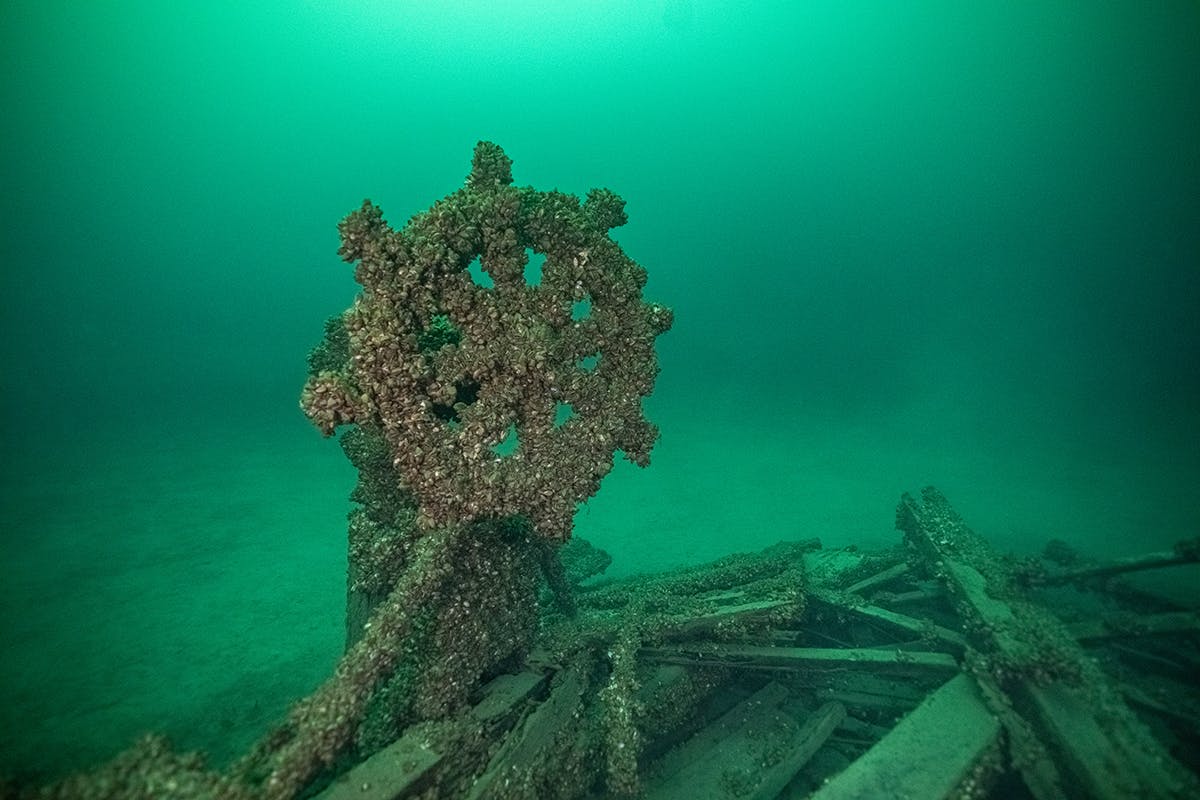 The wheel of the submerged Oliver Mowat (Photo: Kayla Martin)
The wheel of the submerged Oliver Mowat (Photo: Kayla Martin)
On the afternoon of 1 September, 1921, the three-masted schooner, the Oliver Mowat, set out from Picton for Oswego to collect 550 tons of coal, doing the kind of run she had done since her first launch in 1873. At the helm was the capable and careful Captain VanDusen. She sailed into a clear but dark night—the moon was a sliver.
The Oliver Mowat never reached her destination.
As the Gazette reported at the time, “Shortly before 11 o’clock that night, as the vessel was off the Main Ducks in Lake Ontario, a freighter was seen approaching from the east. The night was clear, and the barge continued on its course, although a signal was flashed by the schooner to give warning of her position. The barge came ahead and struck the Oliver Mowat amidships, plowing her way half through.”

The schooner sank in a matter of minutes. The Captain and the ship’s mate, Jacob Corby, tried to rescue the ship’s cook, Carrie McGuigan, who had retired to bed, but she could not be reached. All three went down with the ship.
Although the crew of the Keywest, the offending freighter, attempted to rescue the crew, only two could be brought to safety. Ultimately, the Captain and Mate of the Keywest would be brought to trial.
The Gazette reported three weeks later, “Two of the three masts projecting from the water at a point two miles on the far side of Main Ducks islands, mark the scene of the disaster.” A temporary buoy was installed to mark the masts as dangerous to passing ships.
The following spring, the masts were taken down with blasts of dynamite. For the next 75 years, the exact location of the wreck was lost — until County-born diver Barbara Carson rediscovered it in 1996, 121 feet below the surface of the lake.
Ms. Carson “is a bit of a legend in the shipwreck diving community,” according to friend and fellow diver Kayla Martin. Over a decades-long career beginning in the 1950s, “it’s easier to list the wrecks she didn’t find than the ones she did.”
At the time of the rediscovery, it was customary to keep locations secret to protect sunken treasures from divers wanting a souvenir. But times have changed. Ms. Carson and her team, now retired, now understand that the wrecks she discovered are cultural artifacts that will not last forever.
New technologies, such as three-dimensional photogrammetry, record and preserve underwater treasures. Ms. Carson decided to entrust the Oliver Mowat’s location to Ms. Martin’s team to document and mark the site. Her one requirement was that the new team would place a secure mooring at the site.
“So that way everyone could come and see this beautiful wreck and no longer keep it secret and hidden. It’s a part of our mission to educate about how to be a low-impact diver and how we can protect and enjoy these wrecks,” said Ms. Martin.
Later this month Ms. Martin’s team will install a mooring buoy at the site in cooperation with Save Ontario Shipwrecks. She will then notify the Coast Guard of the coordinates, and release them to the public. Divers are waiting for the announcement. Ms. Martin’s team’s interactive 3-D photogrammetry models of the Oliver Mowat are available at 3dshipwrecks.org.
Ms. Martin is an environmental scientist at University of Waterloo, and a heritage ambassador for Save Ontario Shipwrecks. She’s been diving since she was thirteen. She described Ms. Carson’s moment of realization that the shipwrecks she had visited just a couple of decades before had changed and degraded, spurring her to pass on the location and the guardianship of the Oliver Mowat to Ms. Martin.
She has secured funding for the recording of the Oliver Mowat, “the holy grail of Ontario shipwrecks,” from the Canadian Geographical Society, Save Ontario Shipwrecks, and the Ontario Marine Heritage Committee.
In general, “Picton is one of the best diving locations in Canada,” she notes. “It has the beautiful wrecks that divers want to see, nice clear water in the summer. The wrecks are slightly deeper, so it’s a little bit harder to get the algae build up. Everyone comes to Picton.”
“In fact, my dive club has several charters already booked for this season. The Oliver Mowat will create a massive influx of diving tourism for Picton. Several people are already struggling to find hotels to stay in. Opening a shipwreck up like this really brings out a whole community.
The Picton Gazette’s reporting from the time of the sinking is available in “From the Archives” at pictongazette.ca.
See it in the newspaper